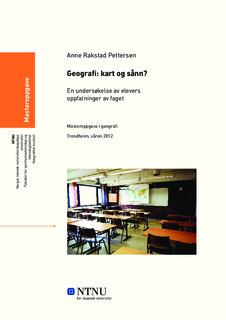| dc.contributor.advisor | Fjær, Olav Bremer | nb_NO |
| dc.contributor.author | Pettersen, Anne Rakstad | nb_NO |
| dc.date.accessioned | 2014-12-19T14:26:12Z | |
| dc.date.available | 2014-12-19T14:26:12Z | |
| dc.date.created | 2013-04-24 | nb_NO |
| dc.date.issued | 2012 | nb_NO |
| dc.identifier | 617714 | nb_NO |
| dc.identifier.uri | http://hdl.handle.net/11250/265458 | |
| dc.description.abstract | This thesis examines pupils’ perceptions of geography. A common perception is that geography’s key concepts are maps and encyclopedic knowledge of other people and places. For those who have not studied geography, others' idea of the subject may seem rather vague. Pupils' perceptions were chosen as a focus, because of my education as a teacher.
I total 250 pupils, both from primary schools and upper secondary schools, took part in a survey. In primary schools geography along with history and social studies are joined in the subject social studies. In upper secondary schools, geography is a separate common course subject in the academic specialization education programmes. There are three research problems investigated: 1) What kinds of perceptions do pupils have of geography? 2) Which age-related differences exist among pupils’ perceptions of geography? 3) How do teachers arrange their method of teaching in geogr aphy, and do pupils’ perceptions of geography have any connection with these?
This thesis focuses primarily on pupils’ perceptions of the subject, but the teachers’method of teaching and the possible relationship between these are also investigated. This due to the influence the teachers have in the daily encounter with the pupils in teaching the subject. 5 of the pupils’ teachers took part in interviews.
Both quantitative and qualitative methods have been used to analyze the results of these studies. This thesis concludes that the pupils emphasize the importance of the map and encyclopedic knowledge of places. The pupils agree on the importance of the map; however upper secondary school pupils also consider the earth landforms as the most important concept in geography. The majority of upper secondary school pupils think about physical geography rather than human geography. The teachers have extensive freedom in their theaching of the subject and use a variety of teaching aids. Most frequently used methods were lecturing, conversations and exercise solving. More time was spent on certain parts of the syllabus than others. In secondary schools written tests and hand-ins were the most frequently used forms of assessment, whereas in primary schools self-evaluations, smaller tests and quizzes were used. The pupils’ perceptions of geography were partly a consequence of how they have been taught the subject. | nb_NO |
| dc.language | nor | nb_NO |
| dc.publisher | Norges teknisk-naturvitenskapelige universitet, Fakultet for samfunnsvitenskap og teknologiledelse, Geografisk institutt | nb_NO |
| dc.title | Geografi: kart og sånn?: En undersøkelse av elevers oppfatninger av faget | nb_NO |
| dc.type | Master thesis | nb_NO |
| dc.contributor.department | Norges teknisk-naturvitenskapelige universitet, Fakultet for samfunnsvitenskap og teknologiledelse, Geografisk institutt | nb_NO |
